By Paul Acquaro
Thursday, November 1st
The Haus der Berliner Festspiele is a mid-century modern split-level architectural gem and it is more than a stones throw away from the typical environs for Berlin experimental jazz, like the scrappy Soweiso or Donau115, or even the slick Radial System V, host to the annual A’Larme Festival. But for a long weekend this month the Jazzfest Berlin successfully transformed the posh address into a destination for daring music.
 |
| TRANS LUCENT & Lunatic Cloud Ten. Photo © Camille Blake. |
It was fantastic mix and mash of media and personalities: at the opening night concert there was a cyclops playing a triangle, a kiosk where you could mash up your own music, a woman poised with a translucent globe out on the front lawn, and more music than one could possibly hear. The festival spread itself out both physically into the neighborhood and thematically, including a focus on Chicago and Europe, an artist in residence from New York City, as well as panel discussions on various topics. But first and foremost, the festival positioned itself in opposition to the forces that are fast at work pulling apart the post-war order that we have relied on for 70 years. Opening the festival was a speech by Dr. Bonaventure Soh Bejeng Ndikung, who is, according to his bio, an independent curator, art critic, author and biotechnologist, and whom attempted to answer how in fact can jazz can actually be poised to ‘do’ something.
“We are caught up in these dire moments, gripped in the claws of the extreme political and socio-economic exigencies of our times … Times in which the shift to the extreme right, the resurrection of proto-fascism, the fortification of authoritarianism is no longer just a fear of something to come, but a reality— as we witness racists, misogynists, xenophobes and neo-liberals democratically elected in the USA, Brazil, Italy, Poland, India, England or Cameroon, and the rise of far-right political movements in Germany or England.” I’m now paraphrasing terribly, but in times of such stress, Ndikung explained, people create visions of Utopias. Jazz, he suggested, could help people imagine how it could be, and in doing so, provide a space to share vulnerabilities, a place to regroup and galvanize their forces (read it here). It was a provocative talk and provided a context for the festival – where it was possible to immerse oneself in a musical utopia and share in a day long ” 360° Multi-channel Installation / Live Processing Installation & Happening/Party” with the aforementioned cyclops, visit panel talks like “Afrofuturismus & Empowerment”, and take a walk through the neighborhood and hear intimate concerts at a hair dresser and someone’s living room.
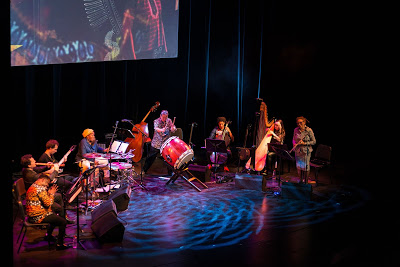 |
| Nicole Mitchell’s Black Earth Ensemble .Photo © Camille Blake. |
Fittingly, the speech was followed by flutist Nicole Mitchell’s Black Earth Ensemble playing the music from her “Madolra Awakenings II” album, which itself is a soundtrack to a story of a not so unimaginable future in which a technically sophisticated egalitarian society – the last place untainted by pollution, corruption, famine, and war – exits isolated on an island. Mitchell kicked off the concert by poking at the screen of her iPod. This was soon followed by a percussive groove colored by the bassoon and splashes of guitar. As the tempo picked up, Mitchell joined in on her flute, playing along with exotic trills from the wooden flute. The loose groove ended in a pregnant pause and then was slowly revived by the shamisen (a Chinese stringed instrument) and the crystalline plucks of the harp. The role of the iPod also became clear as electronic noises appeared, sometimes helping, sometimes clashing, with the musicians. After alternating sections of light hummable melodies, deep pocketed rhythms, and open exploration, vocalist Avery R. Young joined. His speaking/singing parts layered on other meanings and were tinged with gospel accents and invocations, climaxing by declaring “we’re just doing the same thing over and over again.”
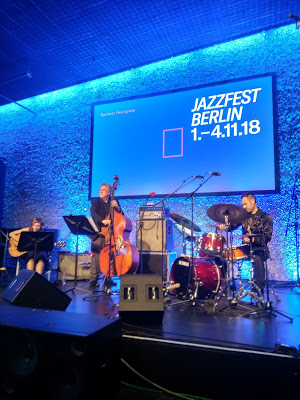 |
| Thumbscrew |
By the time the final song ended, I had already absconded upstairs to the upper foyer where the trio Thumbscrew – guitarist Mary Halvorson (the festival’s artist in residence), drummer Tomas Fujiwara, and bassist Michael Formanek – were set up and ready to hit, which they did when the applause from the main hall subsided. Dressed sleek in black and grey, and poised stylishly against the stone walls, the group dug onto their complex compositions, beginning with “Snarling Joys” off of their recent album ‘Ours’. A glitch with Formanek’s bass pick-up introduced a bit of extra drama while Halvorson’s patented pitch bends, coupled with reverse loops, provided even more urgency to the tunes. In fact, her solo seemed to have an extra edge to it, perhaps in reaction to the bassist’s growing frustration with the equipment. The chemistry between the musicians was obvious, and the devilish lines and sophisticated arrangements of the tunes shined through effortlessly. About halfway through the set, sound problems addressed, Formanek dedicated the set to city of Pittsburgh which had just suffered a horrific, racist mass shooting in a Synagogue. They followed with a melancholic and beautiful song featuring an impassioned solo by the bassist.
 |
| Trio Heinz Herbert |
Tough choices followed, as competing concerts were scheduled on opposite sides of the venue. I chose the Swedish group, Trio Heinz Herbert, who have just released a live album on Intakt records. The shaggy trio’s psychedelic pastiche of space sounds, rock oriented explosions, and acoustic/electronic sonic textures was captivating and equally energetic and exploratory. Egged on by the array of analog electronics and heavy keyboards, I imaged this like being at an early Soft Machine concert, where the intersection of jazz, rock, composition, and improvisation was being explored with inventive fervor. The mixture of slide guitar, somewhat random percussion, and unpredictable keyboard playing made sure that nothing felt pre-planned. The group, overall, was more about pulse and texture than melody and several times they rode their spacey explorations to throbbing climaxes.
 |
| Exploding Star International: Chicago – Berlin. Photo © Camille Blake. |
Satisfied, I wandered over to the main stage for the final event of the night, American cornetist Rob Mazurek’s Exploding Star International: Chicago – Berlin, a mix of both his large group concept “The Exploding Star Orchestra” and more than a handful of Berlin musicians, including the keyboardists Magda Mayas and Elias Stemeseder, and vibraphonist Els Vandeweyer. The group began with Mazurek conducting the group with the percussive clatter of the shell shaker. As the music formed, Mazurek picked up his cornet and blew a few notes directly at the table full of electronics, then essentially ceded the brass work to trumpeter Jamie Branch whose laser like tone cut through the roil of percussionists Chad Taylor and Hamid Drake. Towards stage left, vocalist Damon Locks was scribbling along with the music before picking up an old fashioned telephone receiver and delivering evocative and charged vocal screeds. The group spent at least 20 minutes building up – the tension was great – and it seemed like something was ready to burst. A tense moment passed where it sounded like rain falling on glass, then it comes: the band hits a chord and Drake takes a short but powerful drum solo. Then another chord, increasing in pitch, and Drake takes his mallets to the floor toms. Another hit, the pitch is climbing, then someone plays an off-kilter melody, and then *poof* it’s gone, no explosion. At least not yet. Instead we are treated to wonderful musical moments where Mazurek’s arrangements burst in colors, making synesthetes of us all. Powerful passages, like Branch’s solo riding on a powerful musical riff, or Stemeseder’s distorted solo on the Fender Rhodes, or Vandeweyer’s solo on vibraphone, were spine-tingling, however, there were also some long meandering points that made the piece about 20 minutes too long. Regardless, it was easy to leave the first night of the event, slightly tired from all of the input, but incredibly charged by the music.
Friday, November 2nd
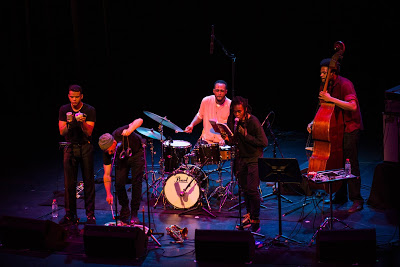 |
| Irreversible Entanglements. Photo © Camille Blake. |
On the second night there was less to decide. With focused attention on the main stage, the evening began with the political and social justice bend of Irreversible Entanglements. It began with a klang, saxophonist Keir Neuringer with the percussive shells, and vocalist Camea Ayewa (aka Moor Mother) with basic electronics, a rattle of percussion from Tcheser Holmes on drums, a rumble of bass from Luke Stewart, and some atmospheric swishes from trumpeter Aquiles Navarro. The band is the right band for the times, as Ayewa’s poetry and politically charged words are urgent and revolutionary. They invoke timeless oppression and emotional opposition and feel like an unending call-to-action as the group weaves fiery free jazz and energy under and around the kinetic words. Their debut album on International Anthem was a hit and it’s a pleasure to see them on the international stage.
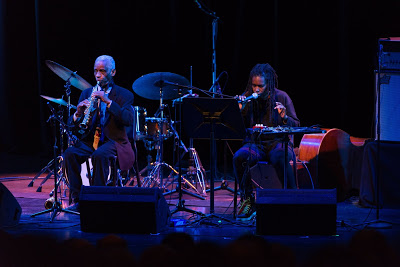 |
| Roscoe Mitchell and Camea Ayewa. Photo © Camille Blake. |
Following, Camea Ayewa and saxophonist Roscoe Mitchell performed an intimate duo set. Two strong personalities on stage – Mitchell with his focused seriousness, and idiosyncratic musical language, and Ayewa with her evocative, serious lyrics, and powerful delivery – played off of each other successfully. Mitchell’s high pitched soprano cry, supported by his circular breathing, is a dominant sound, and Ayewa matches it with her intensity. Her lyrics here seemed to touch on a more personal level, invoking images of family and traditions, while Mitchell provided a musical thread for her to hang the words on. The two engaged in a dynamic conversation, alternating dynamics, pitches, and timbres, sometimes reacting and sometimes ignoring each other.
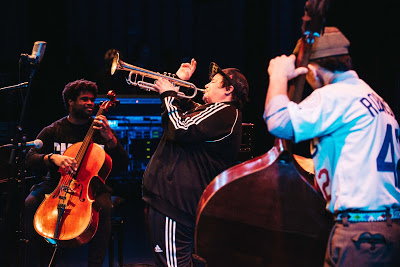 |
| Jamie Branch Fly or Die. Photo © Camille Blake. |
They were followed by Jamie Branch, who also burst onto the musical world recently with her International Anthem album Fly or Die. Branch and her group launched into their epic musical journey, which book-ends wandering through dark musical passages with catchy and up-tempo and memorable riffs. The cello and bass combination in the rhythm section is perfect for this type of exploration, and when they finally coalesce around a strong riff, Branch climbs the musical peaks with precision. Throughout, she navigates the free exploratory stretches with an identifiable and focused tone. Towards the end she says “we play this music in hopes of peace” and asked the for the audience’s help to invoke the names of Michael Brown and Sandra Bland – two African Americans who were the victims of police violence in the US. At first, it seemed like a disconnect, but then, thinking about the musical darkness and light just witnessed, the promise of justice seems to be something both far away but hopefully on the horizon … something to dream about together.
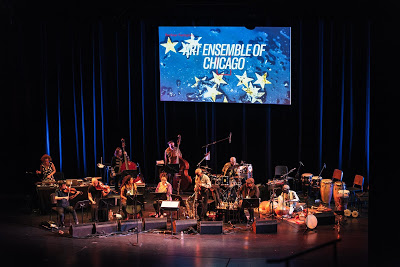 |
| Art Ensemble of Chicago. Photo © Camille Blake. |
The night ended with a highly anticipated set by the Art Ensemble of Chicago. Nicole Mitchell, who also performed with the ensemble, introduced them reminding the audience that their last performance in Berlin was twenty seven years ago. Last summer, the ensemble performed at the Jazzwerkstatt festival in Peitz, located a few hours outside Berlin. That concert turned out to be a bit of a disappointment, but their return to Berlin was a different story. At Peitz the group had been a sextet with two bassists, cello, sax, trumpet, and percussion, however here, the ensemble had expanded to eleven pieces. Retaining the core of Roscoe Mitchell, trumpeter Hugh Ragin, percussionist Fomaudou Don Moye, bassist Jaribu Shahid, and cellist Tomeka Reid, the newer faces included violist Eddy Kwon, violinist Jean Cook, bassist Silvia Bolognesi, percussionist Dudu Kouate, vocalist and electronics Christina Wheeler, and flutist Nicole Mitchell. The first half of the show saw Roscoe Mitchell conducting the group. After a soft trumpet introduction, and a response from the flute, Camea Ayewa joined the group on stage. She delivered syncopated and spiky vocals, which connected quite well with the groups music. The focus then shifted to Wheeler’s electronic Mbira and vocals, after which the pulse picked up as the spotlight moved to the percussionists and then to the strings, and finally back to Ayewa. Mid-way, Mitchell shifted from conductor to player and delivered a fleet uptempo solo. Next, Nicole Mitchell wrapped the en rapt audience with a slinky metallic line and the band shifted into traditional jazz after a long brainy trip. As the music morphed and changed, each player bringing briefly a new focus and sound, and after contributions from Ragin, and Shahid on a bass ukelele, the band settled into their ending theme and closed the night triumphantly.
Sunday, November 4th
Saturday found the festival spilling out of the confines of the Haus into the neighborhood, including the nicely appointed A-Trane and Quasimodo jazz clubs. Sunday began with the Kiez Spaziergang – a collection of intimate concerts at secret neighborhood venues which I would have liked to have attended but was too slow to realize that one needed to have prearranged their access. I am sure that hearing Ingrid Laubrock and Susan Alcorn in the wild was a nice way to start a Sunday.
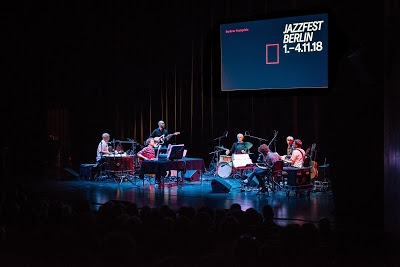 |
| Kym Myhr. Photo © Camille Blake. |
I rejoined the festivities for “Melancholy Sunday” back at the Haus in the large hall – crowded to capacity. The night began with a large ensemble led by Norwegian guitarist Kym Myhr. With four guitarists and three drummers, there seemed to be a lot of possibilities. The first of the two songs hinted at this promise with large sweeping soundscapes of strummed guitars and building tension hinted at coming storm, as drummer Tony Buck played an excellent extended solo. However, they seemed to pull back before going over the edge, and the second song couldn’t seem to break free from a rather uneventful strumming pattern.
 |
| Mary Halvorson Octet. Photo © Camille Blake. |
Next up was the Mary Halvorson Octet. It has been interesting seeing and hearing this band develop over the years. An early concert, before they recorded “Away with You”, it had been shaky but pointed to where they were going. A series of shows at the Village Vanguard seemed to have cemented their sound, and here they played an exciting and original set, which seemed ready to point Jazz in a new direction. The set began with the lonesome wail of Alcorn’s pedal steel guitar. While called a ‘guitar’, it really is it’s own musical beast, and Alcorn’s unusual chord voicings and shimmering notes make for an excellent partner to Halvorson’s piercing slippery bends. The real joy of this band however is how Halvorson writes for the horns – the excellent saxophonists Ingrid Laubrock and Jon Irabagon, trumpeter David Ballou, and trombonist Jacob Garchik. Each member had their chances to shine with ample solo opportunities and with the composed passages that ranged from Raymond Scott-like to the Ellingtonian. Halvorson herself laid back and took only a few spotlight moments, one being a playful and powerful duet with Alcorn.
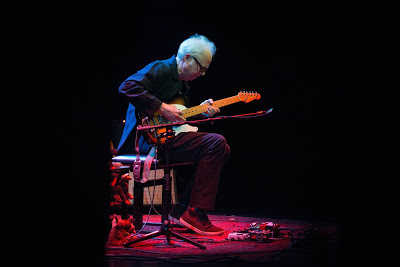 |
| Bill FrisellPhoto © Camille Blake. |
The Octet was followed by a solo set from Bill Frisell. Drawing from his recent “Music Is” recording, he began with a light folksy tune deliberately plucked out on the telecaster. It is solid ground for the guitarist who has always embraced ‘Americana’ in his music and this latest album, and performance, is a recasting of his music in a solo setting. Rethinking older songs and stripping back his tunes to their skeleton, he seems to be finding new momentum. The most successful tune of the night was ‘Baboucar’ from his 2003 album The Intercontinentals and mid-set a bunch of Thelonious Monk tunes appeared which fit Frisell’s approach perfectly. The encore with Mary Halvorson was a nice summation of the night, but it was also a little bit of a let down. Perhaps the contrast between Halvorson’s approach and Frisell’s austere lines is still a little too broad, but nevertheless, they played the title track from their new duo recording on Tzadic Maid with the Flaxen Hair to enthusiastic applause.
Overall, it was a satisfying closing night to an overall exciting festival, and one which answered affirmatively a question posed during the opening night by Dr. Ndikung when he asked “if jazz died in Berlin, could Berlin also be a point of revivification?”. While my experience at the festival was just a sampling of the the whole thing, it was enough to take a look towards the future, rooted in the accomplishments of the past, and if the crowds here mean anything, they seemed pretty enthused to checking out where jazz is headed.

